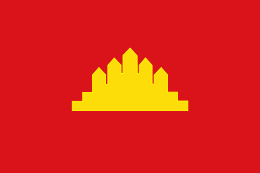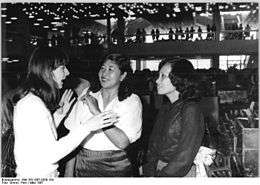Kampuchean United Front for National Salvation
| Kampuchean United Front for National Salvation (KUFNS) រណសិរ្សសាមគ្គីសង្គ្រោះជាតិកម្ពុជា Front Uni National pour le Salut du Kampuchéa (FUNSK) | |
|---|---|
|
Emblem of the KUFNS at the former head office in Phnom Penh | |
| Dates of operation | 2 December 1978 |
| Motives | Overthrowing the Khmer Rouge state and establishing the PRK |
| Active region(s) | Cambodia |
| Ideology | Pro-Soviet Marxism–Leninism |
| Notable attacks | Invasion of Cambodia |
| Status | Transformed into the Solidarity Front for Development of the Cambodian Motherland (2006 – present) |


The Kampuchean (or Khmer) United Front for National Salvation (Khmer: រណសិរ្សសាមគ្គីសង្គ្រោះជាតិកម្ពុជា; KUFNS), often simply referred to as Salvation Front or by its French acronym FUNSK (Front Uni National pour le Salut du Kampuchéa), was the nucleus of a new Cambodian regime that would topple the Khmer Rouge and later establish the People's Republic of Kampuchea (PRK).[2]
History
Its foundation took place on 2 December 1978 in Kratié Province near the border with Vietnam at a meeting of seventy dissident Cambodians determined to overthrow Pol Pot's government. Heng Samrin was voted as leader of the front and within a few weeks its influence spread widely on both sides of the border.[3] The front was a heterogeneous Cambodian politico-military organization that legitimized the Vietnamese invasion of Cambodia, precipitating the ensuing defeat of the Khmer Rouge's Democratic Kampuchea. It brought about the foundation of the new state named 'People's Republic of Kampuchea' and the reconstruction of the shattered and desperately impoverished country. This organization has undergone various name changes as it has expanded and adapted to the different historical realities in Cambodia.
The Salvation Front (1978-1981)
Politically the Salvation Front (FUNSK) was a pro-Hanoi umbrella organization of the Marxist Kampuchean People's Revolutionary Party (KPRP) opposed to the Communist Party of Kampuchea —also known as the Angkar. The original FUNSK group was formed within Cambodia in an area around Kratie that had been liberated from the Khmer Rouge by Cambodian Communists and Khmer Rouge defectors.[4] The latter didn't share Pol Pot's growing personality cult and his increasingly anti-Vietnamese policies. Many felt personally threatened by the bloody purges in Eastern Cambodia in 1977, especially after So Phim's murder at the hand of members of the pro-Pol Pot faction.[5]
The date of the Salvation Front's foundation was December 2, 1978, in what Khmer socialist militants called a "Reunion Congress".[6] The aim of the FUNSK was to expand as a Cambodian front in order to overthrow Pol Pot's regime of terror. The Salvation Front drew eleven points for the reconstruction of the country. These points would be used after the establishment of the PRK to motivate Cambodians to support the rebuilding efforts and the pro-Soviet structure of the new state to keep the revolution alive with a moderate, pragmatic and humane approach compared to the Khmer Rouge. Although the front was largely controlled by KPRP communists, it included quite a few non-communists in its leadership, such as Cambodian Buddhist religious figures, as well as women.[7]
Central Committee of FUNSK consists of 15 members, Heng Samrin as Chairman, Chea Sim as vice president, Ros Samay as secretary general. Revolutionary People's Council decreed on January 8, 1979: Heng Samrin (Chairman), Vice Chairman: Pen Sovan. Headed by Heng Samrin, Revolutionary People's Council of Kampuchea includes Hun Sen (Foreign Affairs), Keo Chenda (Culture and Information), Mot Sakun (Economy), Chea Sim (Interior), Pen Sovan (Defense), Nu Beng (Health and Social Affairs), and Chan Ven (Education).
Kampuchean United Front for National Construction and Defence (1981-2006)
In 1981, two years after the liberation of Phnom Penh, the Salvation Front was renamed "Kampuchean United Front for National Construction and Defence", Front d'union pour l'édification et la défense de la patrie du Cambodge (KUFNCD or UFCDK). [8] Years after the establishment of the People's Republic of Kampuchea, the Front remained as the main political organization of the pro-Hanoi Cambodian state. The front's role in the political life of the nation was officially established in the PRK Constitution, which stated in Article 3 that "The Kampuchean Front for National Construction and the revolutionary mass organizations constitute a solid support base of the state, encouraging the people to fulfill their revolutionary tasks."
Honorary Chairman: Heng Samrin
Chairman: Chea Sim
Solidarity Front for Development of the Cambodian Motherland (2006 – present)
On the 5th congress of the Kampuchean United Front for National Construction and Defence, held in Phnom Penh, on 29 April 2006, the name of the KUFNCD was changed to "Solidarity Front for Development of the Cambodian Motherland", Front de solidarité pour le développement de la Patrie du Cambodge (SFDCM).[9]
This organization, so important in its heyday, has lost much of its original relevance in Cambodian present-day politics.
Chairman: Heng Samrin
Honorary Chairman: Chea Sim
Tasks
The Front's specific missions were to transmit party policies to the masses, to act as an ombudsman, and to mobilize the people around the regime's efforts to consolidate the so-called "worker-peasant alliance." The front's cadres were required to stay in close touch with the people, to report their needs and problems to authorities, and to conduct mass campaigns to generate support for the regime, or to lead "emulation" drives to spur the population to greater efforts in pursuit of specific goals.
The cadres were also responsible for organizing networks of Salvation Front activists in villages and in communes and for coordinating their functions with cadres of various mass organizations. Often this involved long indoctrination sessions and getting villagers to paint banners and hoardings related to the Salvation Front propaganda. This created some resentment in the eyes of the people who perceived that the effort could have been directed towards more productive work.[10]
The Front also was responsible for conducting "activities of friendship," which were aimed at improving the climate for close cooperation with "the Vietnamese people and the Vietnamese army and experts." Another major function of the front was to reeducate Buddhist monks so that they would "discard the narrow-minded views of dividing themselves into groups and factions" and would participate more actively in the revolutionary endeavors of the Salvation Front.
Presently the Solidarity Front for Development of the Cambodian Motherland (SFDCM), the Salvation Front's latest avatar, organizes national and international events, such as sports venues and trade fairs on behalf of the Cambodian government.
Organizations
Among the more important mass organizations affiliated with the KUFNCD as an umbrella organization were the following:
- Kampuchean Federation of Trade Unions (KFTU). It had 62,000 members in December 1983 and was officially described as "the training school of the working class for economic and administrative management".
- Kampuchean People's Revolutionary Youth Union (KPRYU), an important reservoir of candidate members for the KPRP and "a school of Marxism" for people between the ages of fifteen and twenty-six. As of March 1987, when the Youth Union held its Second National Congress, there were more than 50,000 members in villages, factories, enterprises, hospitals, schools, public offices, and the armed forces.
- Kampuchean Revolutionary Youth Association (KRYA), an 800,000- member group for children (aged 9 to 16).
- Kampuchean Young Pioneers Organization (KYPO), a 450,000-member group for preschoolers under the general guidance of the KPRYU and the KRYA, both part of the Pioneer movement.
- Kampuchean Revolutionary Women's Association (KRWA), which claimed 923,000 members as of October 1983.
Commemorative dates
All the organizations under the KUFNCD held rallies to arouse public awareness on national commemorative occasions such as the following:
- Kampuchea-Vietnam Solidarity Day on 18 February.
- Day of Hatred ("against the genocidal Pol Pot-Ieng Sary-Khieu Samphan clique and the Sihanouk-Son Sann reactionary groups") observed on 20 May.
- Day of Solidarity between the People and the Army celebrated on 19 June.
See also
- People's Republic of Kampuchea
- Lê Đức Thọ
- List of political parties in Cambodia
- History of Cambodia
- Patriotic and Democratic Front of the Great National Union of Kampuchea
Bibliography
- Bekaert, Jacques, Cambodian Diary, Vol. 1: Tales of a Divided Nation 1983-1986, White Lotus Press, Bangkok 1997, ISBN 974-8496-95-3,
- Gottesman, Evan, Cambodia after the Khmer Rouge: Inside the politics of Nation Building.
- Vickery, Michael, Cambodia : 1975-1982, Boston: South End Press, 1984
References
- ↑ Margaret Slocomb, The People's Republic of Kampuchea, 1979-1989: The revolution after Pol Pot ISBN 978-974-9575-34-5
- ↑ David P. Chandler, A history of Cambodia, Westview Press; Allen & Unwin, Boulder, Sydney, 1992
- ↑ Ben Kiernan, The Pol Pot Regime: Race, Power and Genocide in Cambodia under the Khmer Rouge, 1975-1979. Page 442
- ↑ Michael Vickery, Cambodia 1975-1982
- ↑ Ben Kiernan, The Pol Pot Regime: Race, Power, and Genocide in Cambodia under the Khmer Rouge, 1975–79. New Haven: Yale University Press, ISBN 978-0-300-14434-5, 1996
- ↑ Kathleen Gough, Interviews in Kampuchea; Bulletin of Concerned Asian Scholars, Vol. 14, 1982
- ↑ Role of Buddhism in Cambodian Life
- ↑ Library of Congress / Federal Research Division / Country Studies - Cambodia - Major Political and Military Organizations
- ↑ Vietnamese News Agency - Cambodge: Le PPC veille à la grande union nationale 29 April 2006 -- 22:04(GMT+7)
- ↑ Soizick Crochet, Le Cambodge, Karthala, Paris 1997, ISBN 2-86537-722-9
External links
- A Country Study: Cambodia
- Margaret Slocomb, The K5 Gamble: National Defence and Nation Building under the People's Republic of Kampuchea